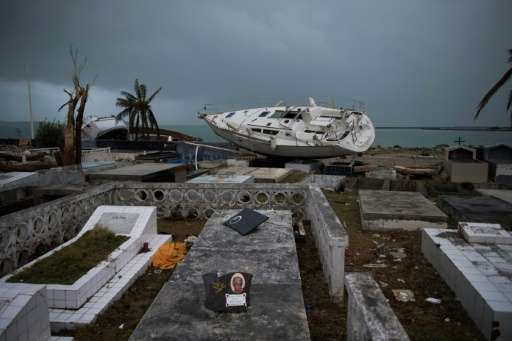A sailing boat is beached in the cemetery of Marigot, St Martin after Hurricane Irma
The biggest threat to human life during a hurricane is often the storm surge, which occurs when sea level rises dramatically during a storm, sending a wall of water gushing over land.
Forecasters warn that the storm surge from Hurricane Irma could reach 15 feet (4.5 meters) along parts of the Florida coast in the coming hours.
Here are some facts about storm surge and what makes it so dangerous.
How does it start?
Storm surge does not come from rainfall or flooding, but occurs when powerful winds from a hurricane push ocean water higher than usual over the shore.
Storm surge is an "abnormal rise of water generated by a storm, over and above the predicted astronomical tides," according to the National Oceanic and Atmospheric Administration (NOAA).
Why is it so deadly?
Storm surge begins before the hurricane makes landfall, making it harder for people to evacuate in time.
Most of the 1,800 deaths from Hurricane Katrina, which struck Louisiana in 2005, are attributed to storm surge, NOAA said.
Storm surge can extend for dozens of miles inland, filling buildings with water quickly, making roads impassable and causing people to drown in their cars or homes.
Also, the accumulated weight of water—some 1,700 pounds per cubic yard— can demolish any structure not specifically designed to withstand such force.
Factors that shape surge
Storm surge is shaped by a number of different factors, including storm intensity, forward speed, the size of a storm and the angle of approach to the coast.
The underlying features of the land at the coast, including bays and estuaries, are also at play.
"A shallow slope will potentially produce a greater storm surge than a steep shelf," said NOAA.
The Louisiana coastline has a wide and shallow continental shelf, which can produce a 20-foot storm surge in a Category 4 hurricane.
Miami Beach, on the other hand, has a steep dropoff to its continental shelf, which could limit the storm surge to about eight or nine feet under a Category 4 hurricane.
Even as Irma takes aim at Florida's west coast, both coasts of the peninsula can expect storm surge.
On the west coast, storm surge could reach as far as seven miles (11 kilometers) inland, meteorologists say.
Unknowns
Rising seas and warming oceans due to climate change are also expected to amplify the effects of storm surge in the coming decades.
Numerous studies have predicted that storm surges will become more frequent and deadly as the planet warms.
© 2017 AFP
























